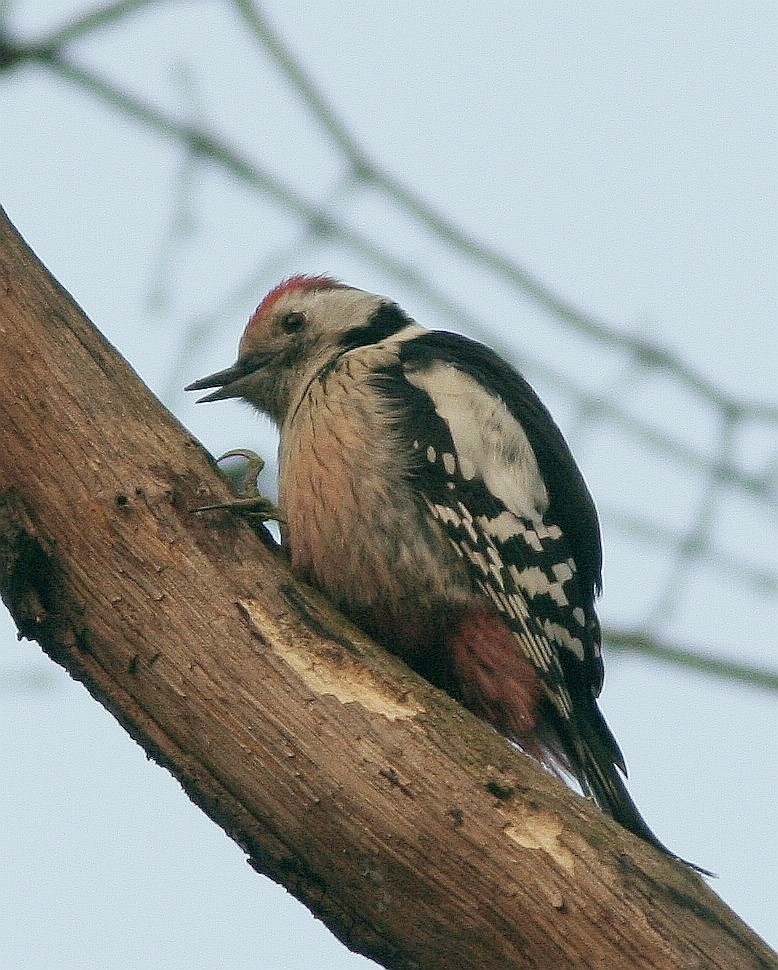Middle Spotted Woodpecker
A species of Eurasian Pied Woodpeckers Scientific name : Dendrocoptes medius Genus : Eurasian Pied Woodpeckers
Middle Spotted Woodpecker, A species of Eurasian Pied Woodpeckers
Botanical name: Dendrocoptes medius
Genus: Eurasian Pied Woodpeckers
Content
Description General Info
Description
The middle spotted woodpecker is 20–22 cm long and has plumage similar to the great spotted woodpecker. As with that species the upperparts are predominantly black with white oval wing patches and white barring on the wings, and the underparts are white. The main differences are a red crown, lack of a black moustachial stripe, a pink vent, and dark streaks on the flanks. Although only slightly smaller than the great spotted woodpecker, it appears smaller due to its short, slender bill and more rounded, pale head. It can also be confused with the Syrian woodpecker (particularly juveniles), being distinguished from this by the smaller bill, and the red crown not having narrow black sides. 
Size
22 cm
Colors
Black
Red
White
Pink
Life Expectancy
8 years
Nest Placement
Cavity
Feeding Habits
Middle Spotted Woodpecker primarily consumes insects and larvae, foraged from branches and twigs rather than under bark. It also feeds on tree sap, showcasing a specialized diet among woodpeckers.
Habitat
The middle spotted woodpecker occurs only in Europe in the Palearctic, from northern Spain and France east to Poland and Ukraine, and south to central Italy (where local), the Balkan Peninsula, Lithuania, Latvia, Turkey, the Caucasus, and Iran. This species used to breed in Sweden but became extirpated in the '80s. However, middle spotted woodpeckers have been seen in Sweden in appropriate breeding habitats after the extirpation. Due to its sedentary nature it has never been recorded in Great Britain. It prefers deciduous forest regions, especially areas with old oak, hornbeam and elm, and a patchwork of clearings, pasture and dense woodland. 
Dite type
Insectivorous
General Info
Feeding Habits
Bird food type
Behavior
Behaviourally it likes to feed high in the trees, moving constantly and making a good view difficult. In the breeding season it excavates a nest hole about 5 cm wide in a decaying tree trunk or thick branch. It lays four to seven eggs and incubates for 11–14 days. The middle spotted woodpecker lives predominantly on a diet of insects as well as their larvae, which it finds by picking them from branches and twigs rather than hacking them from beneath the bark. It will also feed on tree sap. It is rarely heard drumming, and never for territorial purposes, which it asserts by song; a slow, nasal gvayk gvayk gvayk gvayk gvayk. Calls include a fast kik kekekekek. 
Distribution Area
The middle spotted woodpecker occurs only in Europe in the Palearctic, from northern Spain and France east to Poland and Ukraine, and south to central Italy (where local), the Balkan Peninsula, Lithuania, Latvia, Turkey, the Caucasus, and Iran. This species used to breed in Sweden but became extirpated in the '80s. However, middle spotted woodpeckers have been seen in Sweden in appropriate breeding habitats after the extirpation. Due to its sedentary nature it has never been recorded in Great Britain. It prefers deciduous forest regions, especially areas with old oak, hornbeam and elm, and a patchwork of clearings, pasture and dense woodland. 
